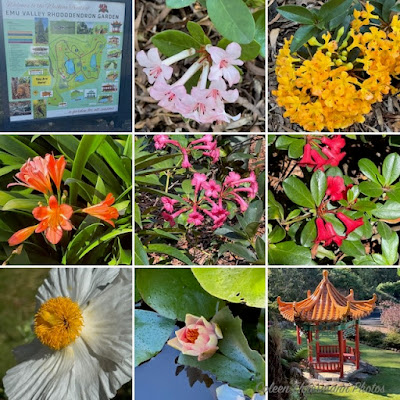The focus of the garden is the flowers and trees, but my focus was the platypus. Our guide was up front with us; we may or may not see any of the resident platypuses (platypi?) in any of the three garden ponds. I endured the up hill, down hill narrow paths wandering through the flowerless gardens (it was the end of summer). The information I remembered from our guide is the garden is maintained by aging volunteers. And like with organizations in the U.S. the Emu Valley Garden is having trouble finding local younger people to take an interest in the gardens so it can continue as a tourist destination in Burnie, Tasmania.
Finally, we approached one of the three ponds and all eyes were pealed on the surface of the pond water.
Finally, a squeal! I see one!
The platypus uses its duck bill to disturb the mud at the bottom of the pond to unearth food. We were told to look for cloudy spots on the water as it would indicate a platypus at work.
It was digging near the shoreline on this photo. We waited for it to surface and when it did, was some distance away from the cloudy water.
OFD's best photo of one of the residents
Platypus Facts from National Geographic Kids:
- Duck-billed platypuses are small, shy animals.
- They have a flattened head and body to help them glide through the water. Their fur, dark brown on top and tan on their bellies, is thick and repels water to keep them warm and dry even after hours of swimming.
- A platypus' snout is quite soft and covered with thousands of receptors that help the platypus detect prey.
- Platypuses are bottom feeders, scooping up insects and larvae, shellfish, and worms in their bill along with bits of gravel and mud.
- An unlikely mix of duck, beaver, and otter, the male platypus also has poisonous stingers (a spur) on his rear feet.
- Folds of skin cover the eyes and ears of the platypus to prevent water from entering, and the nostrils close with a watertight seal.
From the San Diego Zoo Wildlife Alliance:
- Often forage 10 to 12 hours per day; longer in some locations and seasons
- Females lay eggs, 1-3 eggs, usually 2
- Females lack nipples; milk exuded through skin patches
- Few platypuses in zoos; currently, two reside at the San Diego Zoo Safari Park, all others in Australian collections
- Size: 17-20 inches
- Weight: 1.5-5.3 pounds
- Lifespan: 17 years
Conservation Status: Near Threatened
I did see flowers at the end of our tour of the Emu Valley Rhododendron Garden, although they were NOT rhododendrons. They were colorful but secondary to the platypus sightings.
I/we were fortunate enough to see platypuses at the Taronga Zoological Park in Sydney.
Lots of little people and their parents were also looking at the aquarium displays, so getting a swimming photo was impossible. This one is under the branch, waiting to slide into the water.
a lighter colored fur underbelly than the rest of the body
The platypus was hunted for its fur, but it has been a legally protected species in all states where it occurs since 1912. The word platypus comes from the Greek word meaning flat-foot.
Back to Burnie, Tasmania for a final comment or two...
We were the last cruise ship of the season in Burnie. The mayor of Burnie climbed onto our bus to welcome us to her community and to thank us for visiting Burnie. (Our driver told us she welcomes all visitors on the buses if her duties allow.) She then invited us to visit the Visitor's Center where locals had hand-crafted items for sale. While Hubby and I looked for the nearby first geocache find in Tasmania, OFD went shopping. When she showed her cute purchase, I was on a hunt. I, too, needed a hand-crafted platypus!
I finally found the lady selling hand-crafted wool items
I now have a platypus to remind me of this amazing cruise
and the real life platypus sightings
This concludes the New Zealand & Australia cruise posts.













No comments:
Post a Comment
Thanks for your comments!